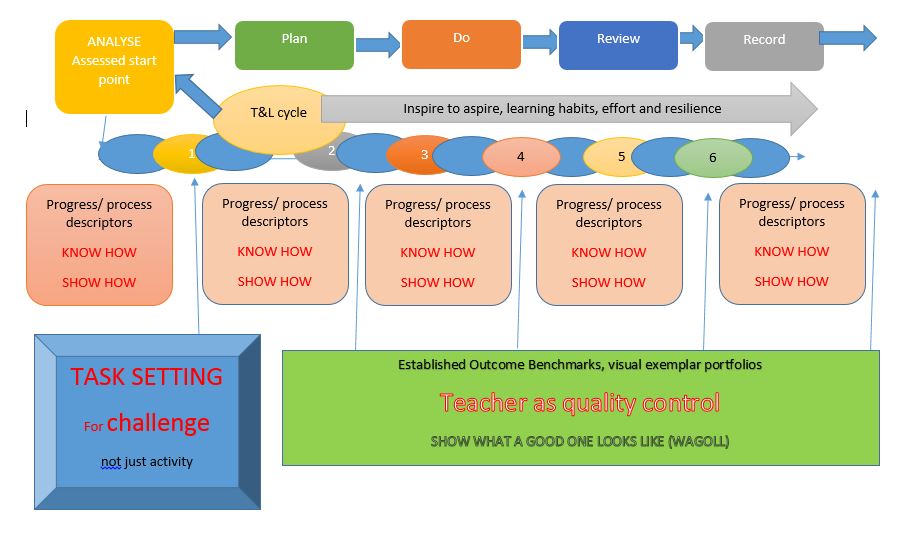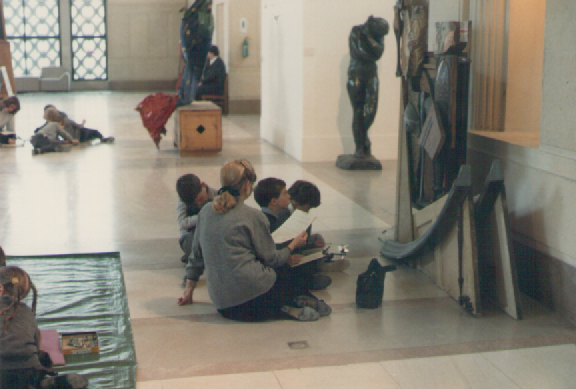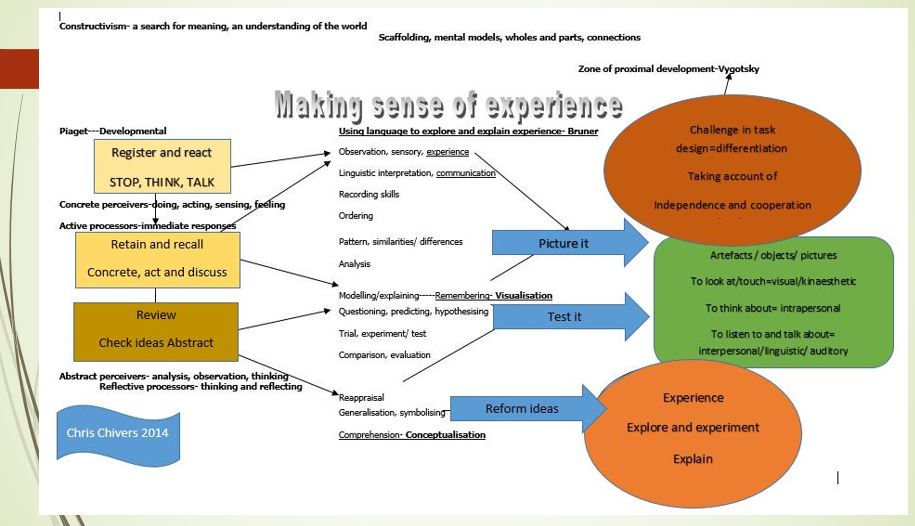What are “they” being given to “do”, after the teacher has shared essential information and when they are charged with follow up tasks? Is it “do an activity”, “follow the instructions” or “think and solve a problem”?
It is, in reality down to how the learners have been tasked, how engaging and challenging it is, the thinking that is generated, the energy they expend in undertaking the task and their involvement in seeking to make it the best possible outcome, so that their pride in their achievements spills over into the next piece of work.
One local inspector once started a day of CPD with staff by introducing the idea that if you give a level 1b child a 1b task, at the end of it, the child will still be 1b. This was a prompted by the fact that the photocopier had taken hold of some staff, who were reflecting less on the challenge in a task, just seeking interesting activities, from colleagues, books or the internet and making 30 copies. Fortunately, there were other colleagues who could articulate a more tailored view of challenge to their learners.
The best tasks make learners think, retrieve what they already know to bring to bear on the task in hand, to consider the framework and strategy for their investigation, the information and resources that they need, their personal and group organisation (as appropriate), how they will record their progress, the timescales available, so how they will use their time effectively.
This approach fits equally well in formal lessons as well as in more open situations. Learner awareness of task needs is a central element of success.
There is much talk of Learning Objectives, Success Criteria, sometimes of WALT and WILF, and how successful, or otherwise, the approach is in supporting learning.
There is a danger that all words used in education become stale through usage. The terms above can become the stereotype of a good start to a lesson. In reality, the Learning Objective, or the WALT, is the statement of what the lesson is about, whereas the Success Criteria or WILF is a series of statements which define successful task outcomes. Beyond these, there will be personalised challenges, known to the child and the teacher. They should be use to state the theme, the challenge and what constitutes an expected outcome.
Task Setting (What’s the challenge?)
Limitations can be embedded in the activities that are given to children. Task setting is, in my mind, the determinant of progress. Real learning, at least to me, requires embedding what is known into overcoming a challenge and solving problems. Much school learning is based on activities, doing, following a set of instructions, rather than applying knowledge and skills to appropriately challenging scenarios. This “recipe” approach to teaching can be effective in the right hands, as can all approaches. However in the wrong hands it embeds a limitation, created by the task. A level x task, given to a level x learner, will produce level x learning.
Creating challenge is therefore an essential teacher skill.
Unpicking the level of challenge, the need for learners to think, to plan, to organise, to select, to determine routes and ideas rather than just follow instructions, is an important aspect.
The process of learning has to be a dynamic interplay between the learner and the context, making active links between what is already known and what is being laid before them. To that end the interplay of the formal lessons, homework and time between lessons would also appear, to me, to be critical.
How much of current homework is an unrelated activity, just because homework has to be given? What if the challenge was continuous, so that homework became pre-thinking, preparation for the lesson, or a reflection on the learning outcomes of the current one, perhaps even developing a note form that supports future revision?
Boxing everything embeds potential limitations, in inexperienced hands, but sometimes in more experienced hands, as a result of internal system. From that point of view, the diagram at the header is limited as can imply boxes rather than a dynamic. The problem of models.
Knowledge and Skills
Learners need to know things in order to understand the world around them. Knowledge underpins all thinking, but the awakening by teaching or discovery through experience of new knowledge has to be explored in relation to what is already known. Making coherent links, and creating memorable chunks of knowledge, is essential.
The knowledge area provides the context for the learning, sometimes in discrete subject areas, sometimes in less discrete manner; the real world does not exist in subject boxes, especially for younger children. The discrete area allows specific concepts, (current) knowledge and subject specific skills to be explored and developed to hone the skills over time to provide capacity to explore for oneself, at different levels, each of which, I would argue has validity.
One does not have to reach a specific level of expertise before using what is known to explore. As a teenager, I was interested in entomology, not as an expert, but as a way to explore the natural world. It was a specific interest, but linked with GCE and A level studies, allowed deeper insights in a very specific area.
The skills of the subject provide the essential process skills, and it is this area that needs careful consideration. Evaluation of outcomes allows the reflective teacher and learner to unpick the application of knowledge within process skills to determine where any gaps occur.
Active Processing- Making Sense of Things
While a teacher might present knowledge in contexts in ways that they think are suitable for the children in their classes, there is never a guarantee that the message gets across to the learner.
- The teacher language style, and the vocabulary being used might preclude a learner from picking up the essential information that they need to make progress. Not all learners are active listeners and even those who are can miss parts of information as they reflect on an earlier snippet of knowledge.
- Even if the message does get across there is no guarantee that the learner will have the capacity to process the knowledge, in some cases because they do not have prior experiences which allow them to link the new information to a known position. They already have a deficit, which, if undetected, embeds and deepens the deficit, by adding another layer of deficit.
- And, even if they have the capacity to take the information in and to process it, there are some learners who have difficulty in expressing what they know in ways that are acceptable as outcomes.
It is a cyclic event, with each successive outcome creating a new baseline of expectation, based on learning outcomes.
So to simplify the diagram at the header of this post.
- Teaching and Learning is a series of interlocking expectations over time; long, medium and short term.
- Analysis underpins the detail of planning, which in turn describes what will happen in the lesson, during and after which the reflective teacher adjusts expectations to evident outcomes, with appropriate records kept as aides memoire.
- Tasks set embed the expectations of the learning, which should be challenging to thinking rather than activity based.
- The product, the outcome and the process are important, with the latter capable of investigation to discover the aspects which a child finds difficult, receptive, processing or expressive difficulty. The former can be compared to aspirational outcomes and investigated for future learning steps.
- You don’t really know what they know unless they can communicate it to you and there are many routes to communication. It’s not just spoken or written.
That is for the teacher and the learner to determine. If outcomes are discussed with the learner, the learner joins the evaluative journey, with an agreed descriptor of next steps shared.
If there is a “bottom line” expectation, as there is in current Age Related Expectations, this can be explored with learners to establish the personalised route necessary to achieve it.
Plotting and monitoring are key teacher skills.
Showing progress can be challenging for an individual child. Specific support and guidance may be needed. For specific individuals the journey descriptor becomes more of a case study, with greater note made of specific interventions that put outcomes in a clearer light.
Target setting.
This might suffer from being an adult concept, especially for younger learners. Perhaps it would be more useful to talk in terms of what learners are trying to get better at.
Target setting often becomes a hidden agenda, with (teacher-set) targets stuck inside book covers, in another booklet, or in a teacher’s planner, in “teacher speak”. It also suffers in some places from lacking a dynamic; three targets set for a half term review. If not achieved, then reset. It sucks the life out of learners putting effort into their learning.
An alternative approach is to
- Put personalised targets on a fold out slip, at the edge of the exercise book, so that during the lesson, the child and the teacher can be aware of the specific targets.
- This can prompt conversations specific to that child, support the learner’s self-evaluations and also support teacher oral and written feedback, as the slips can be folded out during marking.
- Targets can be achieved, then become non-negotiable in future work, with new ones added.
- This approach also supports record keeping, as the slip forms an on-going record of achievement.
Tasks (should) embed a wide range of challenges for learners, including:-
- Some will be investigative, some problem-solving, some using and applying what is known into new areas. All should be challenging to thinking and have an impact on learner progress. The context for a practice task needs to be considered carefully.
- There will be the intellectual challenge; do they understand the task and the nature of the challenge? Can they perceive the strategies that they will need to fulfil the task? Some of this will be determined by the teacher explanation of the task criteria, and what needs to be done to be successful, ie the success criteria, or what the teacher will be looking for.
- For some there will be the social challenge, such as the ability to cooperate with others in sharing available resources, organising, or being organised by, others.
- Some tasks will challenge independence. This, for the adults, is sometimes a difficult judgement call. Some tasks will need direct adult support, supervision and guidance to be successful. The amount and the detail of the adult support needs to be considered when reflecting on outcomes. What could the learners do for themselves?
For interest these are tasks, extracted from work planning diaries that I have used with young children.
Set up a fair test to find the best colour to wear when walking along the road.
Design and make a device that will project a ping pong ball 4 metres into a container.
Using newspaper, build a framework strong enough to… hold a 100g mass 50cm above a table.. hold a cup of water… hold a cream egg… span a 50cm gap between tables and hold 100/200/500g
Consider how to find out of a full balloon weighs more than an empty one.
How much stretch does an elastic band have?
Using squared paper, always the same size, fold a series of rafts with different area bases and different height sides. Which design holds the greater mass?
Other ideas are embedded in subject related blogs.
We are all, or should be, life-long learners, more often without a teacher. Life offers challenges. We need to create solution finders.



 RSS Feed
RSS Feed
